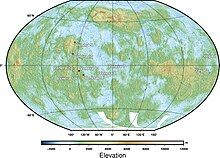
Back Wenera-ruimteprogram Afrikaans برنامج فينيرا Arabic Венера (касмічная праграма) Byelorussian Венера (програма) Bulgarian ভেনেরা কর্মসূচি Bengali/Bangla Programa Venera Catalan Program Veněra Czech Venera-programmet Danish Venera-Programm German Πρόγραμμα Βενέρα Greek
This article needs additional citations for verification. (May 2014) |

The Venera (Russian: Вене́ра, pronounced [vʲɪˈnʲɛrə] 'Venus') program was a series of space probes developed by the Soviet Union between 1961 and 1984 to gather information about the planet Venus.
Thirteen probes successfully entered the Venusian atmosphere, including the two Vega program and Venera-Halley probes. Ten of those successfully landed on the surface of the planet. Due to the extreme conditions, the probes could only survive for a short period on the surface, from 23 minutes to two hours.[1]
The Venera program established a number of precedents in space exploration, among them being the first human-made devices to enter the atmosphere of another planet (Venera 3 on 1 March 1966), the first to make a soft landing on another planet (Venera 7 on 15 December 1970), the first to return images from another planet's surface (Venera 9 on 8 June 1975), the first to record sounds on another planet (Venera 13 on 30 October 1981), and the first to perform high-resolution radar mapping scans (Venera 15 on 2 June 1983).